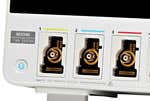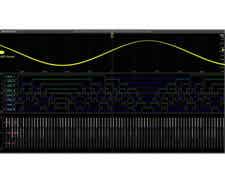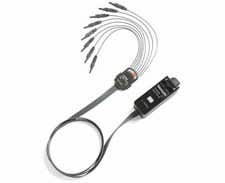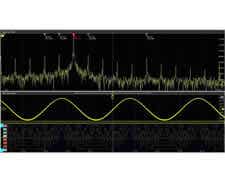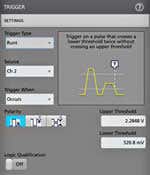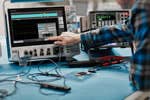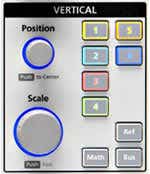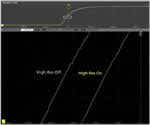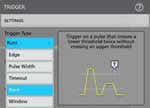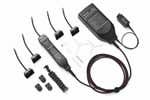Tektronix MSO44GSA 4-BW-200
*US Government Edition* 200 MHz, 4-FlexChannel, 6.25 GS/s Mixed Signal Oscilloscope, 12-bit Vertical Resolution, 31.25 M
Tektronix MSO44GSA 4-BW-200
*US Government Edition* 200 MHz, 4-FlexChannel, 6.25 GS/s Mixed Signal Oscilloscope, 12-bit Vertical Resolution, 31.25 M
The Tektronix MSO44GSA4BW200 *US Government Edition* Mixed Signal Oscilloscope offers better visibility into complex systems with a 13.3-inch HD (1920 x 1080) display and FlexChannel technology. Many applications, such as embedded systems, 3-phase power electronics, automotive electronics, power supply design, and DC-to-DC power converters, , require more than 4 analog signals to debug system issues.
- GSA only; please call direct: (339) 293-4066
- FlexChannels: 4
- GSA only; please call direct: (339) 293-4066
- Number of FlexChannels: 4
- Bandwidth (all analog channels): 200 MHz
- Sample rate (all analog/digital channels): 6.25 GS/s (real-time)
- Vertical resolution: 12 bits ADC (16 bits in High Resolution Mode)
- Display: 13.3 in. color HD (1920 x 1080) capacitive touchscreen
- Standard passive voltage probes with 3.9 pF capacitive loading and 250 MHz analog bandwidth
- Record length (all analog/digital channels): 31.25 Mpoints
- Maximum waveform capture rate: >500,000 waveforms/s
- Standard trigger types:
- Edge, Pulse Width, Runt, Timeout, Window, Logic, Setup and Hold, Rise/Fall Time, Parallel Bus, Sequence, Visual Trigger
- Auxiliary Trigger ≤300 VRMS (Edge Trigger only)
- Standard analysis:
- Cursors: Waveform, V Bars, H Bars, V&H Bars
- Measurements: 36
- FastFrame: Segmented memory acquisition mode with maximum trigger rate waveforms per second
- Plots: Time Trend, Histogram and Spectrum
- Math: Basic waveform arithmetic, FFT, and advanced equation editor
- Search: Search on any trigger criteria
- Optional analysis:
- Spectrum View: Frequency-domain analysis with independent controls for frequency and time domains
- Power Measurements and Analysis
- Optional serial bus trigger, decode and analysis:
- I2C, SPI, I3C, RS-232/422/485/UART, SPMI, CAN, CAN FD, LIN, FlexRay, SENT, USB 2.0, Ethernet, I2S, LJ, RJ, TDM, MIL-STD-1553, ARINC 429
- Arbitrary/Function Generator (optional / upgradable):
- 50 MHz waveform generation
- Waveform Types: Arbitrary, Sine, Square, Pulse, Ramp, Triangle, DC Level, Gaussian, Lorentz, Exponential Rise/Fall, Sin(x)/x, Random Noise, Haversine, Cardiac
- Digital voltmeter (requires free product registration):
- 4-digit AC RMS, DC, and DC+AC RMS voltage measurements
- Trigger frequency counter (requires free product registration):
- 8-digit
- Connectivity:
- USB 2.0 Host, USB 2.0 Device (5 ports)
- LAN (10/100/1000 Base-T Ethernet)
- HDMI (requires connection to high definition display (1,920 x 1,080 resolution))
The Tektronix MSO44GSA4BW200 *US Government Edition* 200 MHz, 4-FlexChannel, 6.25 GS/s Mixed Signal Oscilloscope with 12-bit Vertical Resolution, 13.3 in. HD Touchscreen, 31.25 M offers better visibility into complex systems with a 13.3-inch high-definition (1,920 x 1,080) display and FlexChannel technology. Many applications, such as embedded systems, three-phase power electronics, automotive electronics, power supply design, and DC-to- DC power converters, require the observation of more than four analog signals to verify and characterize device performance, and to debug challenging system issues.
Most engineers can recall situations in which they were debugging a particularly difficult problem and wanted greater system visibility and context, but the scope they were using was limited to two or four analog channels. Using a second scope involves significant effort to align trigger points, difficulty in determining timing relationships across the two displays, and documentation challenges.
FlexChannel® technology enables maximum flexibility and broader system visibility
The MSO44 redefines what a Mixed Signal Oscilloscope (MSO) should be. FlexChannel technology enables each channel input to be used as a single analog channel, eight digital logic inputs (with the optional TLP058 logic probe), or simultaneous analog and spectrum views 4 with independent acquisition controls for each domain. Imagine the flexibility and configurability this provides.
Unprecedented signal viewing capability
The stunning 13.3-inch (338 mm) display in the MSO44 is the largest display in its class. It is also the highest resolution display, with full HD resolution (1,920 x 1,080), enabling you to see many signals at once with ample room for critical readouts and analysis. The viewing area is optimized to ensure that the maximum vertical space is available for waveforms. The Results Bar on the right can be hidden, enabling the waveform view to use the full width of the display.
The MSO44 offers a revolutionary new Stacked display mode. Historically, scopes have overlaid all waveforms in the same graticule, forcing difficult tradeoffs:
- To make each waveform visible, you vertically scale and position each waveform so that they don't overlap. Each waveform uses a small percentage of the available ADC range, leading to less accurate measurements.
- For measurement accuracy, you vertically scale and position each waveform to cover the entire display. The waveforms overlap each other, making it hard to distinguish signal details on individual waveforms.
The new Stacked display eliminates this tradeoff. It automatically adds and removes additional horizontal waveform 'slices' (additional graticules) as waveforms are created and removed. Each slice represents the full ADC range for the waveform. All waveforms are visually separated from each other while still using the full ADC range, enabling maximum visibility and accuracy. And it's all done automatically as waveforms are added or removed! Channels can easily be reordered in stacked display mode by dragging and dropping the channel and waveform badges in the Settings bar at the bottom of the display. Groups of channels can also be overlaid within a slice to simplify visual comparison of signals.
The large display in the MSO44 also provides plenty of viewing area not only for signals, but also for plots, measurement results tables, bus decode tables and more. You can easily resize and relocate the various views to suit your application.
Exceptionally easy-to-use user interface lets you focus on the task at hand
The Settings Bar - key parameters and waveform management
Waveform and scope operating parameters are displayed in a series of "badges" in the Settings Bar that runs along the bottom of the display. The Settings Bar provides Immediate access for the most common waveform management tasks.
The Results Bar - analysis and measurements
The Results Bar on the right side of the display includes immediate, onetap access to the most common analytical tools such as cursors, measurements, searches, measurement and bus decode results tables, plots, and notes.
DVM, measurement and search results badges are displayed in the Results Bar without sacrificing any waveform viewing area. For additional waveform viewing area, the Results Bar can be dismissed and brought back at any time.
Touch interaction finally done right
Scopes have included touch screens for years, but the touch interface has been an afterthought. The MSO44's display includes a capacitive touchscreen and provides the industry's first oscilloscope user interface truly designed for touch.
The touch interactions that you use with phones and tablets, and expect in a touch enabled device, are supported in the MSO44.
- Drag waveforms left/right or up/down to adjust horizontal and vertical position or to pan a zoomed view
- Pinch and expand to change scale or zoom in/out in either horizontal or vertical directions
- Drag items to the trash can to delete them
- Swipe in from the right to reveal the Results Bar or down from the top to access the menus in the upper left corner of the display
Smooth, responsive front panel controls allow you to make adjustments with familiar knobs and buttons, and you can add a mouse or keyboard as a third interaction method.
Attention to detail in the front-panel controls
Traditionally, the front face of a scope has been roughly 50% display and 50% controls. The MSO44 display fills about 75% of the face of the instrument. To achieve this, it has a streamlined front panel that retains critical controls for simple intuitive operation, but with a reduced number of menu buttons for functions directly accessed via objects on the display.
Color-coded LED light rings indicate trigger source and vertical scale/ position knob assignments. Large, dedicated Run/ Stop and Single Sequence buttons are placed prominently in the upper right, and other functions like Force Trigger, Trigger Slope, Trigger Mode, Default Setup, Autoset and Quick-save functions are all available using dedicated front panel buttons.
Digital Phosphor technology with FastAcq™ highspeed waveform capture
To debug a design problem, first you must know it exists. Digital phosphor technology with FastAcq provides you with fast insight into the real operation of your device. Its fast waveform capture rate - greater than 500,000 waveforms per second - gives you a high probability of seeing the infrequent problems common in digital systems: runt pulses, glitches, timing issues, and more. To further enhance the visibility of rarely occurring events, intensity grading indicates how often rare transients are occurring relative to normal signal characteristics.
Industry leading vertical resolution
The MSO44 provides the performance to capture the signals of interest while minimizing the effects of unwanted noise when you need to capture high-amplitude signals while seeing smaller signal details. At the heart of the MSO44 are 12-bit analog-to-digital converters (ADCs) that provide 16 times the vertical resolution of traditional 8-bit ADCs.
A new High Res mode applies a hardware-based unique Finite Impulse Response (FIR) filter based on the selected sample rate. The FIR filter maintains the maximum bandwidth possible for that sample rate while preventing aliasing and removing noise from the oscilloscope amplifiers and ADC above the usable bandwidth for the selected sample rate. High Res mode always provides at least 12 bits of vertical resolution and extends all the way to 16 bits of vertical resolution at ≤125 MS/s sample rates.
New lower-noise front end amplifiers further improve the MSO44's ability to resolve fine signal detail.
Triggering
Discovering a device fault is only the first step. Next, you must capture the event of interest to identify root cause. The MSO44 provides a complete set of advanced triggers, including:
- Runt
- Logic
- Pulse width
- Window
- Timeout
- Rise/Fall time
- Setup and Hold violation
- Serial packet
- Parallel data
- Sequence
- Visual Trigger
With up to a 62.5 Mpoint record length, you can capture many events of interest, even thousands of serial packets in a single acquisition, providing high-resolution to zoom in on fine signal details and record reliable measurements.
Visual Trigger - finding the signal of interest quickly
Finding the right cycle of a complex bus can require hours of collecting and sorting through thousands of acquisitions for an event of interest. Defining a trigger that isolates the desired event speeds up debug and analysis efforts.
Visual Trigger extends the instrument's triggering capabilities by scanning through all waveform acquisitions and comparing them to on-screen areas (geometric shapes). You can create an unlimited number of areas using the mouse or touchscreen, and a variety of shapes (triangles, rectangles, hexagons, or trapezoids) can be used to specify the desired trigger behavior. Once shapes are created, they can be edited interactively to create custom shapes and ideal trigger conditions. Once multiple areas are defined, a Boolean logic equation can be used to set complex trigger conditions using on-screen editing features.
By triggering only on the most important signal events, Visual Trigger can save hours of capturing and manually searching through acquisitions. In seconds or minutes, you can find the critical events and complete your debug and analysis efforts. Visual Trigger even works across multiple channels, extending its usefulness to complex system troubleshooting and debug tasks.
Accurate high-speed probing
The TPP Series passive voltage probes offer all the benefits of general purpose probes - high dynamic range, flexible connection options, and robust mechanical design - while providing the performance of active probes. Up to 1 GHz analog bandwidth enables you to see high frequency components in your signals, and extremely low 3.9 pF capacitive loading minimizes adverse effects on your circuits and is more forgiving of longer ground leads.
An optional, low-attenuation (2X) version of the TPP probe is available for measuring low voltages. Unlike other low-attenuation passive probes, the TPP0502 has high bandwidth (500 MHz) as well as low capacitive loading (12.7 pF).
TekVPI Probe Interface
The TekVPI® probe interface sets the standard for ease of use in probing. In addition to the secure, reliable connection that the interface provides, many TekVPI probes feature status indicators and controls, as well as a probe menu button right on the comp box itself. This button brings up a probe menu on the oscilloscope display with all relevant settings and controls for the probe. The TekVPI interface enables direct attachment of current probes without requiring a separate power supply. TekVPI probes can be controlled remotely through USB or LAN, enabling more versatile solutions in ATE environments. The MSO44 provides up to 80 W of power to the front panel connectors, sufficient to power all connected TekVPI probes without the need for an additional probe power supply.
IsoVu™ Isolated Measurement System (Optional)
Whether designing an inverter, optimizing a power supply, testing communication links, measuring across a current shunt resistor, debugging EMI or ESD issues, or trying to eliminate ground loops in your test setup, common mode interference has caused engineers to design, debug, evaluate, and optimize "blind" until now.
Tektronix' revolutionary IsoVu technology uses optical communications and power-over-fiber for complete galvanic isolation. When combined with the MSO44 equipped with the TekVPI interface, it is the first, and only, measurement system capable of accurately resolving high bandwidth, differential signals, in the presence of large common mode voltage with:
- Complete galvanic isolation
- Up to 1 GHz bandwidth
- 1 Million to 1 (120 dB) common mode rejection at 100 MHz
- 10,000 to 1 (80 dB) of common mode rejection at full bandwidth
- Up to 2,500 V differential dynamic range
- 60 kV common mode voltage range
Basic waveform analysis
Verifying that your prototype's performance matches simulations and meets the project's design goals requires careful analysis, ranging from simple checks of rise times and pulse widths to sophisticated power loss analysis, characterization of system clocks, and investigation of noise sources.
The MSO44 offers a comprehensive set of standard analysis tools including:
- Waveform- and screen-based cursors
- 36 automated measurements. Measurement results include all instances in the record, the ability to navigate from one occurrence to the next, and immediate viewing of the minimum or maximum result found in the record
- Basic waveform math
- Basic FFT analysis
- Advanced waveform math including arbitrary equation editing with filters and variables
- FastFrame™ Segmented Memory enables you to make efficient use of the oscilloscope's acquisition memory by capturing many trigger events in a single record while eliminating the large time gaps between events of interest. View and measure the segments individually or as an overlay.
Measurement results tables provide comprehensive statistical views of measurement results with statistics across both the current acquisition and all acquisitions.
Navigation and search
Finding your event of interest in a long waveform record can be time consuming without the right search tools. With today's record lengths of many millions of data points, locating your event can mean scrolling through literally thousands of screens of signal activity.
The MSO44 offers the industry's most comprehensive search and waveform navigation with its innovative Wave Inspector® controls. These controls speed panning and zooming through your record. With a unique force-feedback system, you can move from one end of your record to the other in just seconds. Or, use intuitive drag and pinch/expand gestures on the display itself to investigate areas of interest in a long record.
The Search feature allows you to automatically search through your long acquisition looking for user-defined events. All occurrences of the event are highlighted with search marks and are easily navigated to, using the Previous ( ← ) and Next ( → ) buttons found on the front panel or on the Search badge on the display. Search types include edge, pulse width, timeout, runt, window, logic, setup and hold, rise/fall time and parallel/serial bus packet content. You can define as many unique searches as you like.
You can also quickly jump to the minimum and maximum value of search results by using the Min and Max buttons on the Search badge.
Serial Protocol Triggering and Analysis (See Options Below)
- Option 4-SREMBD technologies:
- Embedded - I2C, SPI
- Option 4-SRCOMP technologies:
- Computer - RS-232/422/485/UART
- Option 4-SRENET technologies:
- Ethernet - 10BASE-T, 100BASE-TX
- Option 4-SRI3C technologies:
- MIPI I3C - I3C decode and search only
- Option 4-SRPM technologies:
- Power Management - SPMI
- Option 4-SRUSB2 technologies:
- USB - USB2.0 LS, FS, HS
- Option 4-SRAUTO technologies:
- Automotive - CAN, CAN FD, LIN, FlexRay, and CAN symbolic decoding
- Option 4-SRAUTOSEN technologies:
- Automotive sensor - SENT
- Option 4-SRAERO technologies:
- Military and Aerospace - MIL-STD-1553, ARINC 429
- Option 4-SRAUDIO technologies:
- Audio - I2S, LJ, RJ, TDM
During debugging, it can be invaluable to trace the flow of activity through a system by observing the traffic on one or more serial buses. It could take many minutes to manually decode a single serial packet, much less the thousands of packets that may be present in a long acquisition. And if you know the event of interest that you are attempting to capture occurs when a particular command is sent across a serial bus, wouldn't it be nice if you could trigger on that event? Unfortunately, it's not as easy as simply specifying an edge or a pulse width trigger.
The MSO44 offers a robust set of tools for working with the most common serial buses found in embedded design including I2C, SPI, I3C, RS-232/422/485/UART, SPMI, CAN, CAN FD, LIN, FlexRay, SENT, USB LS/FS/HS, Ethernet 10/100, Audio (I2S/LJ/RJ/TDM), MIL-STD-1553, and ARINC 429.
Serial protocol search enables you to search through a long acquisition of serial packets and find the ones that contain the specific packet content you specify. Each occurrence is highlighted by a search mark. Rapid navigation between marks is as simple as pressing the Previous ( ← ) and Next ( → ) buttons on the front panel or in the Search badge that appears in the Results Bar.
The tools described for serial buses also work on parallel buses. Support for parallel buses is standard in the MSO44. Parallel buses can be up to 48 bits wide and can include a combination of analog and digital channels.
- Serial protocol triggering lets you trigger on specific packet content including start of packet, specific addresses, specific data content, unique identifiers, and errors.
- Bus waveforms provide a higher-level, combined view of the individual signals (clock, data, chip enable, and so on) that make up your bus, making it easy to identify where packets begin and end, and identifying sub-packet components such as address, data, identifier, CRC, and so on.
- The bus waveform is time aligned with all other displayed signals, making it easy to measure timing relationships across various parts of the system under test.
- Bus decode tables provide a tabular view of all decoded packets in an acquisition much like you would see in a software listing. Packets are time stamped and listed consecutively with columns for each component (Address, Data, and so on).
| Country of Origin | United States |
|---|---|
| Brand | Tektronix |
| Condition | NEW |
| Replacement | MSO44B4BW200 |
| Vendor Alias | TEK-MSO44GSA 4-BW-200 |
- 1 - *US Government Edition* 200 MHz, 4-FlexChannel, 6.25 GS/s Mixed Signal Oscilloscope with 12-bit Vertical Resolution, 13.3 in. HD Touchscreen, 31.25 M
- 4 - TPP0250 250 MHz Passive Analog Probes
- 1 - Embedded Help
- 1 - Power Cord
- 1 - Calibration Certificate
- 1 - User Manual
- 1 - Three-year Warranty Covering All Parts and Labor on 4 Series MSO Instrument
- 1 - One-year Warranty Covering All Parts and Labor on Included Probes





